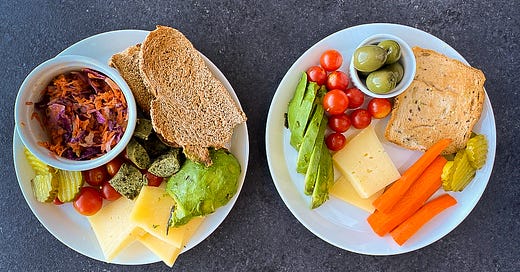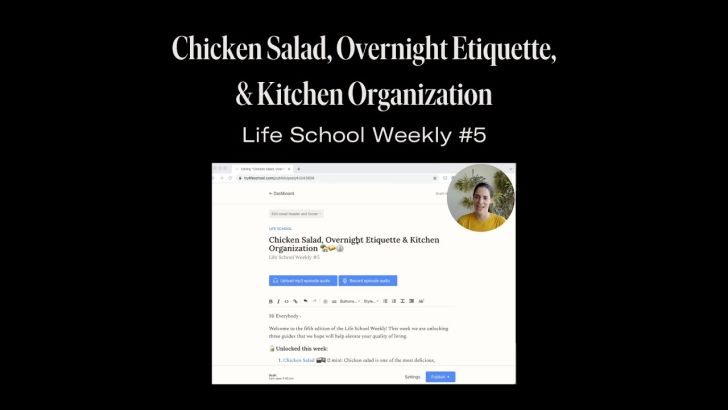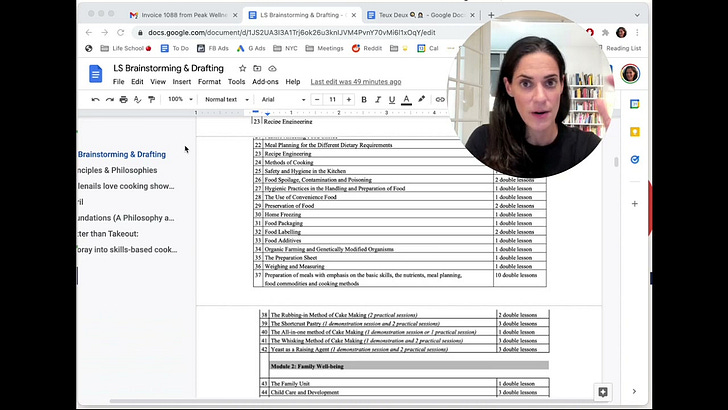This lesson is 406 words, a 1 min 37 second reading time. It is the seventh lesson of Lunch 2.0.
📍 Introduction:
A little resourcefulness, scavenging, and creativity go a long way in making a most satisfying nosh plate. Made up of items like cheeses, nuts, veggies, & meats, the nosh plate is an efficient way to put together a tasty bite fast.
Mixing and matching what you have on hand reduces waste and clears room in your fridge for new additions. Furthermore, by practicing & experimenting, you’ll expand your repertoire and learn what flavor combinations you like best. Go ahead and dig into the back of your fridge. You might be surprised by what you create.
🧂 Ingredients:
Nosh-worthy nibbles
✅ Instructions:
Pick a flat surface (e.g., plate, small cutting board)
Prep ingredients
Arrange the plate
Gather a napkin & utensils (e.g., cheese knife, little spoons, toothpicks)
Nosh!
📓 Nosh Plate Reference Guide:
Cheese: hard/aged (e.g., gouda, gruyere, cheddar), firm/mild (e.g., manchego, jack, havarti, muenster), soft (e.g., blue, brie, mozzarella, chevre/goat)
Vegetables: crunchy (e.g., carrots, celery, peppers, fennel, kale chips, slaw), tender (e.g., snap peas, beets, boiled seasonal vegetables, blanched broccoli, cauliflower), soft (e.g., roasted vegetables).
Meat/protein: deli meat (e.g., ham, salami, mortadella, prosciutto), smoked salmon, boiled egg, tuna salad, sliced tofu, leftovers (e.g., roasted chicken)
Dips/sauces: hummus, pesto, guacamole, salsa, tapenade, chimichurri, baba ganoush, aioli, mustard, ranch
Pantry/condiments: olives, tinned fish (e.g., tuna, anchovies), marinated artichokes, anything pickled (cornichons, capers, b&b pickles, pickled red onions), roasted peppers, toasted nuts (almonds, walnuts, pecans, cashews)
Sweet: jam, honey, nut butter, chocolate, dried fruit (e.g., apricots, cherries, raisins)
Starch: bread, baguette, toast, crackers, pita, chips
Fruit: sliced apple, grapes, figs, oranges, banana, berries, sliced avocado
📝 Notes Tips & Tricks
Varying textures (e.g., crunchy, creamy) and flavors (e.g., salty, sweet, tangy) make for a more delightful nosh.
Extra prep work can go a long way in up-leveling a nosh plate (e.g., thinly slicing fruits/veggies, rolling meats, toasting nuts, serving sauce in a little dish)
When arranging, try to present the items nicely. Contrast colors, textures & shapes for a visually exciting plate.
Most cheeses, charcuterie & roasted veggies taste best at room temperature. Leftovers are often worth reheating.
To be extra next-level, add a few sprigs of herbs or edible flowers as a beautifying garnish.
Fun fact: the word “nosh” is Yiddish and hails from the Middle High German word naschen, which means “to nibble.”
🎓 Further Study
Basic Knife Skills [Life School]
Crudité [Life School]
Sprucing up Leftovers [Life School]
———
📚 Want to learn more? Check out the Table of Contents or Collections.
🎧 Prefer to listen? Subscribe on iTunes, Spotify, or Overcast.
🎳 Team for this lesson: Michelle Tandler & April Word
🗣 Discussion topic: What’s your favorite nosh ingredient? Comment below.













Share this post